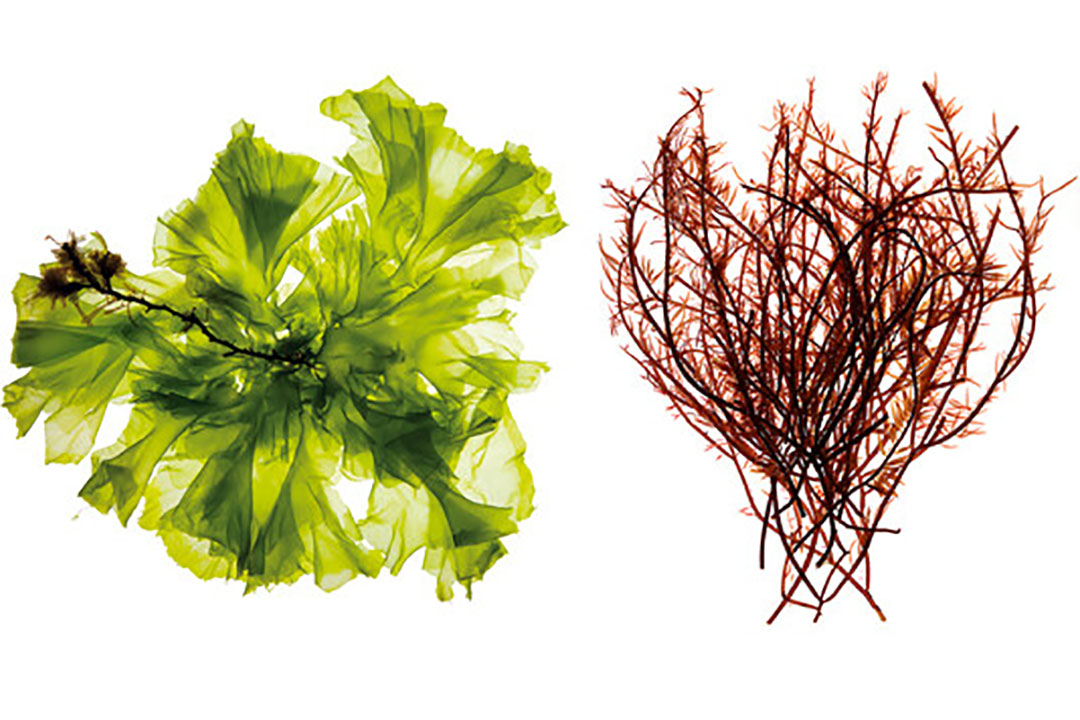Improving immune performance in aquaculture through algae

Recent research results show the potential of in-feed marine macroalgae polysaccharides for improving immune performance in aquaculture.
Macroalgae (seaweeds) play a key role in shaping the marine underwater world, from the seashore down to depths where there is enough light for them to grow. Seaweeds are widely used in the food industry as gelifying, thickening and stabilising agents due to their specific physico-chemical properties.
Reinforcing the intestinal barrier function of animals
Recent scientific work has revealed the potential of in-feed marine macroalgae polysaccharides as reliable agents for modulating the immune function and reinforcing the intestinal barrier function of animals. These are seen as innovative strategies that can lead to greater resilience in animals before stress events such as transport, sorting and vaccinations; they can also help during disease risk periods and when facing environmental challenges.
Unique structural features
Seaweeds are divided into 3 groups:
- brown
- red and
- green algae
Despite their phylogenetic differences, seaweeds share the specificity of their parietal polysaccharides, whose structural complexity and unique composition make them very reactive and explain their bioactivities in relation to animals, plants and humans.
The complexity and reactivity of seaweed polysaccharides derive from the nature of sugar units, which are diverse and sometimes rare, such as uronic acids, xylose and rhamnose. The variety of glycosidic bonds leading to their branched structure and the presence of sulfate groups determines the bioactivities of these molecules (Figure 1).
Figure 1 – A seaweed sulfated polysaccharide structure is responsible for a high level of biological activities.

Furthermore, their polyanionic structure and solubility increase their reactivity and facilitate their recognition by host cells.
The main types of seaweed polysaccharides are:
- agar and carrageenans (red seaweeds),
- ulvans (green seaweeds) and
- fucans (brown seaweeds)
Each of which have specific molecular traits which determine their biological properties and reactivity. This is why it is important to identify which types of polysaccharides are responsible for a given bioactivity, with the aim of extracting and using them for achieving targeted health effects.
Olmix Group marine bioactive ingredient extraction know-how has led to the development of an in-feed product, Algimun, which is based on a combination of 2 bioactive macroalgal extracts: MSP®Barrier, a red algal extract, which enhances the gut barrier function; and MSP®Immunity, a green algal extract, that modulates innate and adaptive immune responses. Algimun bioactive molecules proved resistant to aquaculture feed processing in general, and in particular to extrusion.
Immunomodulating and properties
A research project in collaboration with INRA (France) led to the demonstration of the effect of MSP®Immunity on immune mediator transcription in a IPEC-1 model (epithelial cell line). This included identifying the metabolic pathways involved.
Green algal extract
Green algal extract could positively influence the gene transcription of a wide range of immune mediators involved in defence mechanisms within innate and the adaptive immune responses, including the recruitment and activation of antigen-presenting cells, the differentiation and proliferation of lymphocyte populations, while inducing immune tolerance thanks to its anti-inflammatory properties. In-vivo scientific studies further confirmed the immunomodulating properties of MSP®Immunity, namely by improving the phagocytic activity of macrophages and neutrophils in rainbow trout and also by regulating the gene expression of immune mediators with anti-inflammatory activities in carp macrophages.
Red algal extract
Olmix Group conducted a set of experiments in collaboration with Intestinal Biotech Development in order to assess the effect of the MSP®Barrier on the intestinal barrier function using epithelial cell lines. Results showed that this red algal extract upregulates the gene expression of transmembrane and scaffolding proteins, which are essential for optimal functioning of tight junction complexes. Besides that, the red algal extract upregulates the expression of mucin-targeted genes that play a crucial role in establishing the mucus layer and the preventing pathogen colonisation. Red algal extract also plays an important role in maintaining gut mucosa integrity by making the tight junctions stronger and the mucus layer more functional. These findings were corroborated in an in-vivo scientific study.
MSP®Barrier reduced the paracellular passage of FITC-dextran (gut permeability marker) to the blood in an animal stress model known to cause inflammation of the gut mucosa, leading to a higher degree of gut permeability. MSP®Barrier supplementation to stressed animals significantly reinforced the barrier function of the gut mucosa which is currently at the front line of the innate immune defence.
The effect of macroalgal extracts
Scientific and commercial trials have shown that Algimun inclusion in feed ensures regular growth performance while modulating the immune response and reinforcing the gut barrier function, resulting in enhanced resistance to pathogenic challenges in several species such as red tilapia, rainbow trout, olive flounder and shrimp.
Red tilapia fed with 0.3% of Algimun had a higher survival rate (+25%, p<0.05, figure 2) 14 days after a streptococcus agalactiae challenge due to a better immune response demonstrated by a significant increase in the blood respiratory burst when compared to the control challenge group (p><0.05) and by significantly higher counts of intestinal goblet cells when compared to the control group (p><0.05).
In a rainbow trout commercial farm (Brazil, 2019), the inclusion of 0.3% of Algimun in the feed led to a significantly improved skin-mucus immune response when compared to the control group. The skin mucus complement system activity (hemolysis activity) in trout fed Algimun at week 4 and week 11 was improved by 13% (p<0.05) and 28% (p><0.10), respectively.
What’s more, the hemolytic activity was higher at week 11 compared to week 4 (p<0.001). these results indicate that the product reinforces the skin-mucus innate immune response over time, both in short and long=”term” use, while maintaining regular performance.
These trials confirm that the product can be used as a natural marine in-feed strategy to improve the natural defences and thus improve the resistance of animals to several stressors in aquaculture production systems.
Author:
María García Suárez, For Feed product specialist, Olmix Group











